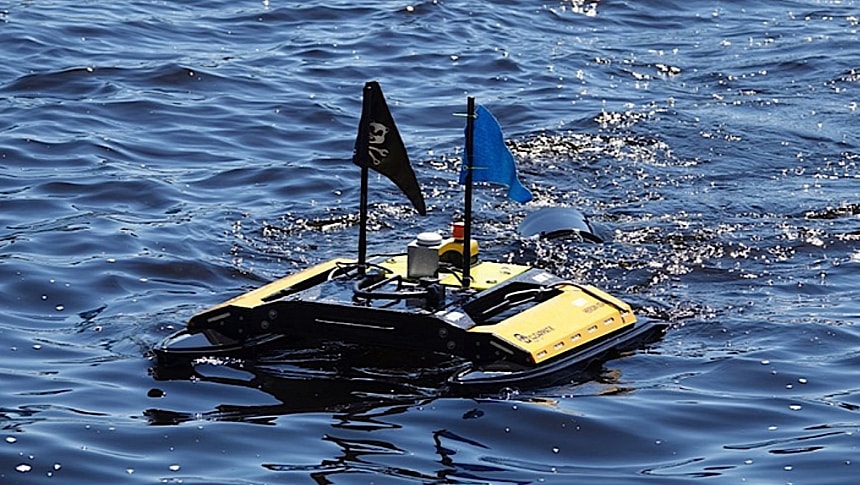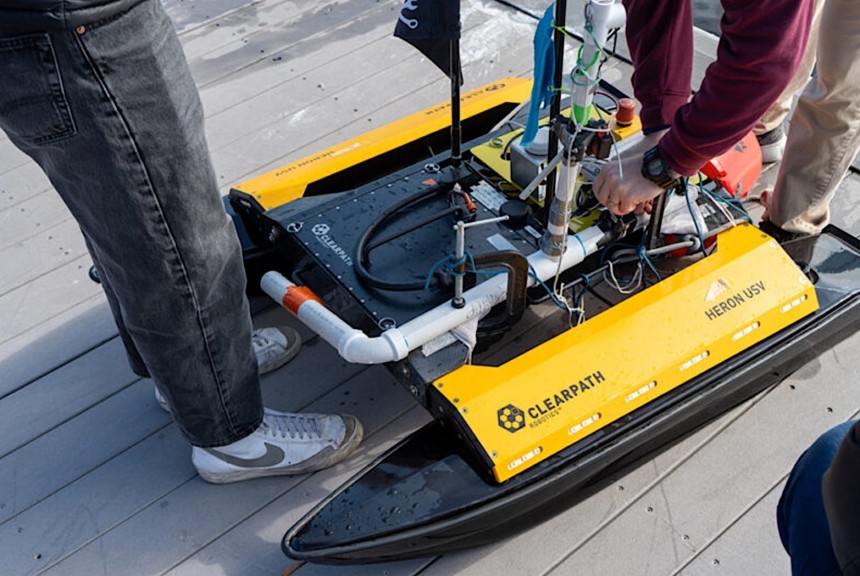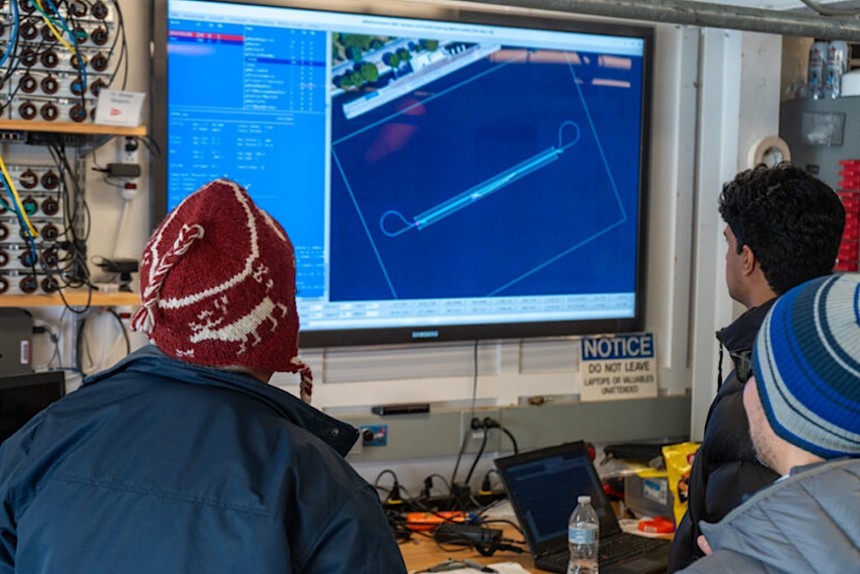Slowly but surely drones are taking over the world. They started by conquering our skies, are now moving to take over land, and will soon become a common sight on and under the waters of the world. So, if you fear a drone-flooded (and partly controlled) future, you'd better look away now.
If you are into military stuff, then the name Aurora Flight Sciences might ring a bell or two. A company owned by Boeing, Aurora most recently came into the news as the maker of an aircraft with diamond-shaped wings and no control surfaces that DARPA calls the X-65 (part of the Control of Revolutionary Aircraft with Novel Effectors – CRANE program).
However, despite being part of an aerospace giant, Aurora is not solely focused on developing aircraft. In fact, the company just revealed it is working to teach uncrewed surface vessels to conduct underway replenishment of ships in conditions they were not designed for.
Underway replenishment, or UNPER, is the practice of transferring supplies, fuel, and munitions from one ship to another. It dates back to the early 20th century, and it is presently used on a very large scale by the U.S. Navy and other militaries across the world.
The way Aurora teaches drones to do this is through something called Fast Adaptation and Learning for Control Online, on FALCON. We're basically talking about a control architecture for sea drones (and possibly even larger, existing ships) that should give them the ability to "adapt their control laws as they encounter conditions not predicted at the time of vehicle design."
Aurora partnered with the Massachusetts Institute of Technology (MIT) Aerospace Controls Laboratory and the MIT Marine Autonomy Laboratory (PavLab) for the project, and announced this week the completion of a series of test ran in the waters of the Charles River in Boston, Massachusetts.
The tests saw an autonomously controlled, unmanned surface vessel go on a simulated resupply mission and use the adaptive control gifted to it by the FALCON to "overcome a variety of disturbances while completing the mission." There were two mission scenarios set out for the sea drone: to perform the UNPER, and to navigate through a simulated Suez Canal.
The first test scenario called for the FALCON system, which was installed in a small unmanned surface vehicle (USV) of the Clearpath Heron variety, to go through the steps needed to autonomously resupply a U.S. Navy ship (a role played by another small surface drone).
As things are done today, UNREP requires people to be on deck for the operation in both the ships involved, the delivery one and the receiving one. That’s because such procedures are mostly done manually.
The FALCON, however, managed to model how the resupply would proceed autonomously while at the same time fighting off obstacles envisioned by its creators. Among these obstacles were a thruster failure and the so-called Venturi effect.
In a nutshell, the Venturi effect translates into the reduction in fluid pressure resulting from the said fluid accelerating through a constricted area. It is one of the most difficult things to model, and also incredibly hard for ships to mitigate. And yet the FALCON seems to have done exactly that, although Aurora does not go into the specifics of it all.
As far as the Suez Canal scenario goes, the idea was to replicate the 2021 incident involving a ship called Ever Given. The incident became known as the 2021 Suez Canal Obstruction because it ended up blocking one of the most important waterways in the world for six full days.
The Ever Given, a 1,300-feet (400 meters) container ship, somehow managed to run aground, wedging itself sideways across the Canal, effectively blocking the way for all other ships. The cause of the incident was identified as a combination of strong winds and bad decisions by the ship's pilot.
In the Aurora test, the USV had to make its way across a virtual canal built along the Charles River. The same Venturi effect mentioned earlier pushed the small vessel towards the banks of this virtual canal, at the exact same moment a thruster failure was simulated and wind power increased by deploying a sail.
The control system, a conventional one, failed under these circumstances, but the FALCON apparently managed to get control of the USV and operate it in a casual manner across the imagined Suez Canal, with no issues whatsoever.
The work Aurora is doing with the FALCON is part of the Defense Advanced Research Projects Agency (DARPA) program called Learning Introspective Control (LINC). Plans are to deploy the system on larger vessels later this spring and see what it can do in more challenging conditions.
Aurora says that FALCON can work not only for ships, but also aircraft and land vehicles. It can be deployed either as an advisor tool, or as the one that's in complete control of everything that a ship, airplane, or car is doing.
We will keep an eye out for more developments on this front and report back once we learn more.
However, despite being part of an aerospace giant, Aurora is not solely focused on developing aircraft. In fact, the company just revealed it is working to teach uncrewed surface vessels to conduct underway replenishment of ships in conditions they were not designed for.
Underway replenishment, or UNPER, is the practice of transferring supplies, fuel, and munitions from one ship to another. It dates back to the early 20th century, and it is presently used on a very large scale by the U.S. Navy and other militaries across the world.
The way Aurora teaches drones to do this is through something called Fast Adaptation and Learning for Control Online, on FALCON. We're basically talking about a control architecture for sea drones (and possibly even larger, existing ships) that should give them the ability to "adapt their control laws as they encounter conditions not predicted at the time of vehicle design."
Aurora partnered with the Massachusetts Institute of Technology (MIT) Aerospace Controls Laboratory and the MIT Marine Autonomy Laboratory (PavLab) for the project, and announced this week the completion of a series of test ran in the waters of the Charles River in Boston, Massachusetts.
The first test scenario called for the FALCON system, which was installed in a small unmanned surface vehicle (USV) of the Clearpath Heron variety, to go through the steps needed to autonomously resupply a U.S. Navy ship (a role played by another small surface drone).
As things are done today, UNREP requires people to be on deck for the operation in both the ships involved, the delivery one and the receiving one. That’s because such procedures are mostly done manually.
The FALCON, however, managed to model how the resupply would proceed autonomously while at the same time fighting off obstacles envisioned by its creators. Among these obstacles were a thruster failure and the so-called Venturi effect.
In a nutshell, the Venturi effect translates into the reduction in fluid pressure resulting from the said fluid accelerating through a constricted area. It is one of the most difficult things to model, and also incredibly hard for ships to mitigate. And yet the FALCON seems to have done exactly that, although Aurora does not go into the specifics of it all.
As far as the Suez Canal scenario goes, the idea was to replicate the 2021 incident involving a ship called Ever Given. The incident became known as the 2021 Suez Canal Obstruction because it ended up blocking one of the most important waterways in the world for six full days.
In the Aurora test, the USV had to make its way across a virtual canal built along the Charles River. The same Venturi effect mentioned earlier pushed the small vessel towards the banks of this virtual canal, at the exact same moment a thruster failure was simulated and wind power increased by deploying a sail.
The control system, a conventional one, failed under these circumstances, but the FALCON apparently managed to get control of the USV and operate it in a casual manner across the imagined Suez Canal, with no issues whatsoever.
The work Aurora is doing with the FALCON is part of the Defense Advanced Research Projects Agency (DARPA) program called Learning Introspective Control (LINC). Plans are to deploy the system on larger vessels later this spring and see what it can do in more challenging conditions.
Aurora says that FALCON can work not only for ships, but also aircraft and land vehicles. It can be deployed either as an advisor tool, or as the one that's in complete control of everything that a ship, airplane, or car is doing.
We will keep an eye out for more developments on this front and report back once we learn more.



















